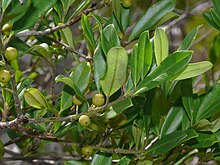Ilex cassine is a holly native to the southeastern coast of North America that grows from Virginia to the Colorado River in Texas, with subspecies growing southward on the Gulf Coast as far as Veracruz, Mexico, and in Cuba, Puerto Rico, and the Bahamas in the Caribbean. It is commonly known as dahoon holly[2] or cassena, the latter derived from the Timucua name for I. vomitoria.[3]
| Ilex cassine | |
|---|---|

| |
| Scientific classification | |
| Kingdom: | Plantae |
| Clade: | Tracheophytes |
| Clade: | Angiosperms |
| Clade: | Eudicots |
| Clade: | Asterids |
| Order: | Aquifoliales |
| Family: | Aquifoliaceae |
| Genus: | Ilex |
| Species: | I. cassine
|
| Binomial name | |
| Ilex cassine | |

| |
| Natural range in United States | |
It is a large shrub or small tree growing to 12 meters (39 ft).[4] The leaves are evergreen, 6–15 cm long and 2–4 cm broad, glossy dark green, entire or with a few small spines near the apex of the leaf. The flowers are white, with a four-lobed corolla. The fruit is a red drupe, 5–6 mm in diameter, containing four seeds.[5][6][7]
As with other hollies, it is dioecious with separate male and female plants. Only the females have berries, and a male pollenizer must be within range for bees to pollinate them.
Varieties
edit- Ilex cassine var. cassine (United States, Caribbean)
- Ilex cassine var. angustifolia Aiton. (United States)
- Ilex cassine var. mexicana (Turcz.) Loes. (Mexico)
Ilex × attenuata is a naturally occurring hybrid of Ilex cassine and Ilex opaca.[8]
Natural range and cultivation
editIlex cassine is indigenous to the southeastern coast of North America and the Caribbean, growing along the margins of waterways and swamps from Virginia to the Colorado River in Texas,[9] with subspecies growing southward as far as Veracruz on the Gulf Coast, and in the Caribbean on the coasts of Cuba, the Bahamas, and Puerto Rico.[10]
It is cultivated in warmer climates as an ornamental plant for the attractive bright red berries set against the glossy green leaves. It is known to grow as high as 12 meters (39 ft).[4]
Stimulant
editIlex cassine leaves, like those of its sister species I. vomitoria, contain measurable amounts of the stimulants caffeine and theobromine. The leaves of both species may have been used in the Native American cassena (the Black drink), and there has been confusion in the literature as to which species was commonly used to brew the drink, but I. vomitoria provides more caffeine and was probably the usual ingredient in cassena.
An analysis of the levels of methylxanthines in the leaves used in various stimulant drinks found that I. cassine leaves have about 20% (by dry weight) of the amount of caffeine found in I. vomitoria, 8% of that in Coffea arabica, and about 3% of the caffeine in Camellia sinensis Kunze. I. cassine has twice as much theobromine as I. vomitoria and 20% of the level in C. sinensis Kunze (C. arabica does not contain significant amounts of theobromine), but the stimulant effect of theobromine is just 10% of that of caffeine.[4]
The Native peoples of Florida used the hollowed-out shells of Lightning Whelks (Busycon contrarium), a kind of sea snail found on the east and west coasts of Florida, as drinking vessels in their black drink ceremonies.[11][4]
References
edit- ^ Rhodes, L.; Maxted, N.; Stritch, L. (2018). "Ilex cassine". IUCN Red List of Threatened Species. 2018: e.T20678718A20695061. doi:10.2305/IUCN.UK.2018-1.RLTS.T20678718A20695061.en. Retrieved 19 November 2021.
- ^ a b c "Ilex cassine". Germplasm Resources Information Network. Agricultural Research Service, United States Department of Agriculture. Retrieved 2011-09-20.
- ^ Austin, Daniel F. (2004). Florida Ethnobotany. CRC Press. pp. 590–591. ISBN 978-0-8493-2332-4.
- ^ a b c d Edwards, Adam L.; Bennett, Bradley C. (June 2005). "Diversity of Methylxanthine Content in Ilex cassine L. and Ilex vomitoria Ait.: Assessing Sources of the North American Stimulant Cassina" (PDF). Economic Botany. 59 (3): 277. doi:10.1663/0013-0001(2005)059[0275:DOMCII]2.0.CO;2. ISSN 0013-0001.
- ^ Florida Department of Environmental Protection: Florida's Hollies Archived 2010-02-09 at the Wayback Machine
- ^ Huxley, A., ed. (1992). New RHS Dictionary of Gardening. Macmillan ISBN 0-333-47494-5.
- ^ "Ilex cassine Fact Sheet". Archived from the original on 2008-05-06. Retrieved 2008-05-07.
- ^ "Ilex × attenuata 'Fosteri'". Plant Finder. Missouri Botanical Garden. Retrieved 6 December 2020.
- ^ Rätsch, Christian (2005). The Encyclopedia of Psychoactive Plants : Ethnopharmacology and Its Applications. Rochester, Vt. : Park Street Press. pp. 284–287. ISBN 978-0-89281-978-2.
- ^ NCCE Staff. "Ilex cassine (Cassine, Cassine Holly, Dahoon, Dahoon Holly, Narrowleaf Dahoon Holly) | North Carolina Extension Gardener Plant Toolbox". plants.ces.ncsu.edu. N.C. Cooperative Extension. Archived from the original on 8 August 2020. Retrieved 18 May 2024.
- ^ Bullen, Ripley P. (September 1978). "Pre-Columbian Trade in Eastern United States as Viewed from Florida". The Florida Anthropologist. 31 (3): 94–95.
External links
edit- Media related to Ilex cassine at Wikimedia Commons
- Data related to Ilex cassine at Wikispecies
- Trees, Shrubs, and Woody Vines of North Carolina: Dahoon (Ilex cassine)
